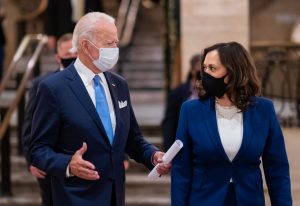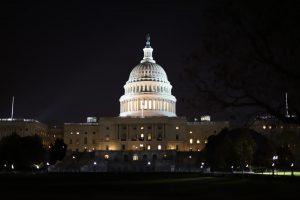President Biden signs executive orders regarding immigration
Provided by U.S. Department of State
Flags of different countries stand outside a 2016 meeting of the International Syria Support Group. “I think we can all come together and agree that Biden’s vision of America is a fundamentally more optimistic one.” Youth Activism Club president Ethan Choi (12) said. “And it’s one that values the impact of immigrants so much more so than [former President] Trump.”
February 1, 2021
In the first days of his presidency, President Biden signed several executive orders regarding immigration, including defending the DACA program, ending the “Muslim-travel ban,” changing immigration enforcement policies and stopping border wall construction. Two weeks later, he signed additional orders establishing a task force for reunifying families separated at the border and reviewing the previous administration’s policies regarding asylum, foreign funding, naturalization and legal immigration.
Biden’s executive order “ending discriminatory bans on entry to the United States” fulfilled a promise he made to Muslim supporters that he announced virtually to a Muslim American advocacy organization at a livestreamed event in July. This order reversed the “Muslim-travel ban” that was issued four years ago, during former President Trump’s first week in office. Since its issuing, more than 41,000 visa requests have been denied. In addition to reversing the ban, Biden’s new order also allows federal immigration agencies to “set civil immigration enforcement policies” and calls for a review of any practices developed in regards to the 2017 executive order and can revise them as necessary.
In addition to the order regarding discriminatory bans, Biden also announced that he will send the U.S. Citizenship Act to Congress. Included in this act is the No Ban Act, which passed in the House six months ago and would prevent presidents in the future from enacting discriminatory travel bans.
Advocates are calling for the government to review all denied cases and allow requests to proceed without additional fees or interviews for people who have already gone through them. They hope this will be the beginning of a more widespread immigration revision effort that will go on to raise the refugee resettlement cap and expand the Deferred Action for Childhood Arrivals (DACA) program.
In regards to DACA, another one of Biden’s executive orders called on the secretary of homeland security to take all appropriate actions to “preserve and fortify” DACA. It is estimated that nearly 646,000 people are enrolled in DACA and 1,331,000 qualify for it, but, under the Trump administration, new applications had stopped being accepted by the government for over three years.
Besides just strengthening the program, Biden urged Congress to pass legislation that would make Dreamers eligible first for permanent residency in the U.S. and then citizenship three years later. In tandem with this, he also proposed immigrants living illegally in the U.S. to be eligible for permanent residency in five years and citizenship in eight. This has received pushback from Republican lawmakers concerned about creating a pathway to citizenship for immigrants who broke the law, which would be roughly 11 million people.
While there have been mixed reactions to Biden’s new orders, his stance on immigration ultimately reflects a different perspective of America than his predecessor.
“I think we can all come together and agree that Biden’s vision of America is a fundamentally more optimistic one.” Youth Activism Club president Ethan Choi (12) said. “And it’s one that values the impact of immigrants so much more so than [former President] Trump.”
Along with his efforts to reverse and review other policies started by the Trump administration, Biden signed an executive order establishing an interagency task force for identifying children separated from their families at the United States-Mexico border between January 20, 2017, and January 20, 2021 and facilitating their reunions with their families. The chair of this task force, Alejandro N. Mayorkas, the first Latino and the first immigrant secretary of homeland security, was sworn into office shortly after the order was signed.
Biden also rescinded the national emergency declaration that President Trump had used to divert roughly $10 billion from the Defense Department accounts toward building a wall on the border of Mexico, directing private contractors to stop work “as soon as possible but in no case later than seven days.” In the meantime, the project will be assessed fully to see if the funding is legal and if the funding can be diverted elsewhere. The proclamation issued directs federal agencies to make a plan to redirect border wall funds and “resume, modify, or terminate” segments of the structure that remain under construction. The previous administration finished 455 miles of new barriers along the Mexico boundary.
Beyond the orders regarding DACA, immigration, and the border wall Biden signed on his first day, he also signed other orders that reversed more of Trump’s policies, such as rejoining the Paris Climate Accord.
“I particularly like the fact that [Biden’s] sort of recommitting the United States to international agreements and efforts,” upper school history teacher Byron Stevens said. “And it underscores an idea of cooperation, which I think does more for United States national interest in the long run, than [a] more of ‘go it alone, America first attitude.’”
Additional reporting by Lucy Ge.


















![“[Building nerf blasters] became this outlet of creativity for me that hasn't been matched by anything else. The process [of] making a build complete to your desire is such a painstakingly difficult process, but I've had to learn from [the skills needed from] soldering to proper painting. There's so many different options for everything, if you think about it, it exists. The best part is [that] if it doesn't exist, you can build it yourself," Ishaan Parate said.](https://harkeraquila.com/wp-content/uploads/2022/08/DSC_8149-900x604.jpg)




![“When I came into high school, I was ready to be a follower. But DECA was a game changer for me. It helped me overcome my fear of public speaking, and it's played such a major role in who I've become today. To be able to successfully lead a chapter of 150 students, an officer team and be one of the upperclassmen I once really admired is something I'm [really] proud of,” Anvitha Tummala ('21) said.](https://harkeraquila.com/wp-content/uploads/2021/07/Screen-Shot-2021-07-25-at-9.50.05-AM-900x594.png)







![“I think getting up in the morning and having a sense of purpose [is exciting]. I think without a certain amount of drive, life is kind of obsolete and mundane, and I think having that every single day is what makes each day unique and kind of makes life exciting,” Neymika Jain (12) said.](https://harkeraquila.com/wp-content/uploads/2017/06/Screen-Shot-2017-06-03-at-4.54.16-PM.png)








![“My slogan is ‘slow feet, don’t eat, and I’m hungry.’ You need to run fast to get where you are–you aren't going to get those championships if you aren't fast,” Angel Cervantes (12) said. “I want to do well in school on my tests and in track and win championships for my team. I live by that, [and] I can do that anywhere: in the classroom or on the field.”](https://harkeraquila.com/wp-content/uploads/2018/06/DSC5146-900x601.jpg)
![“[Volleyball has] taught me how to fall correctly, and another thing it taught is that you don’t have to be the best at something to be good at it. If you just hit the ball in a smart way, then it still scores points and you’re good at it. You could be a background player and still make a much bigger impact on the team than you would think,” Anya Gert (’20) said.](https://harkeraquila.com/wp-content/uploads/2020/06/AnnaGert_JinTuan_HoHPhotoEdited-600x900.jpeg)

![“I'm not nearly there yet, but [my confidence has] definitely been getting better since I was pretty shy and timid coming into Harker my freshman year. I know that there's a lot of people that are really confident in what they do, and I really admire them. Everyone's so driven and that has really pushed me to kind of try to find my own place in high school and be more confident,” Alyssa Huang (’20) said.](https://harkeraquila.com/wp-content/uploads/2020/06/AlyssaHuang_EmilyChen_HoHPhoto-900x749.jpeg)



![Flags of different countries stand outside a 2016 meeting of the International Syria Support Group. “I think we can all come together and agree that Biden's vision of America is a fundamentally more optimistic one.” Youth Activism Club president Ethan Choi (12) said. “And it's one that values the impact of immigrants so much more so than [former President] Trump.”](https://harkeraquila.com/wp-content/uploads/2021/02/Screen-Shot-2021-02-22-at-11.37.14-PM-900x500.png)







